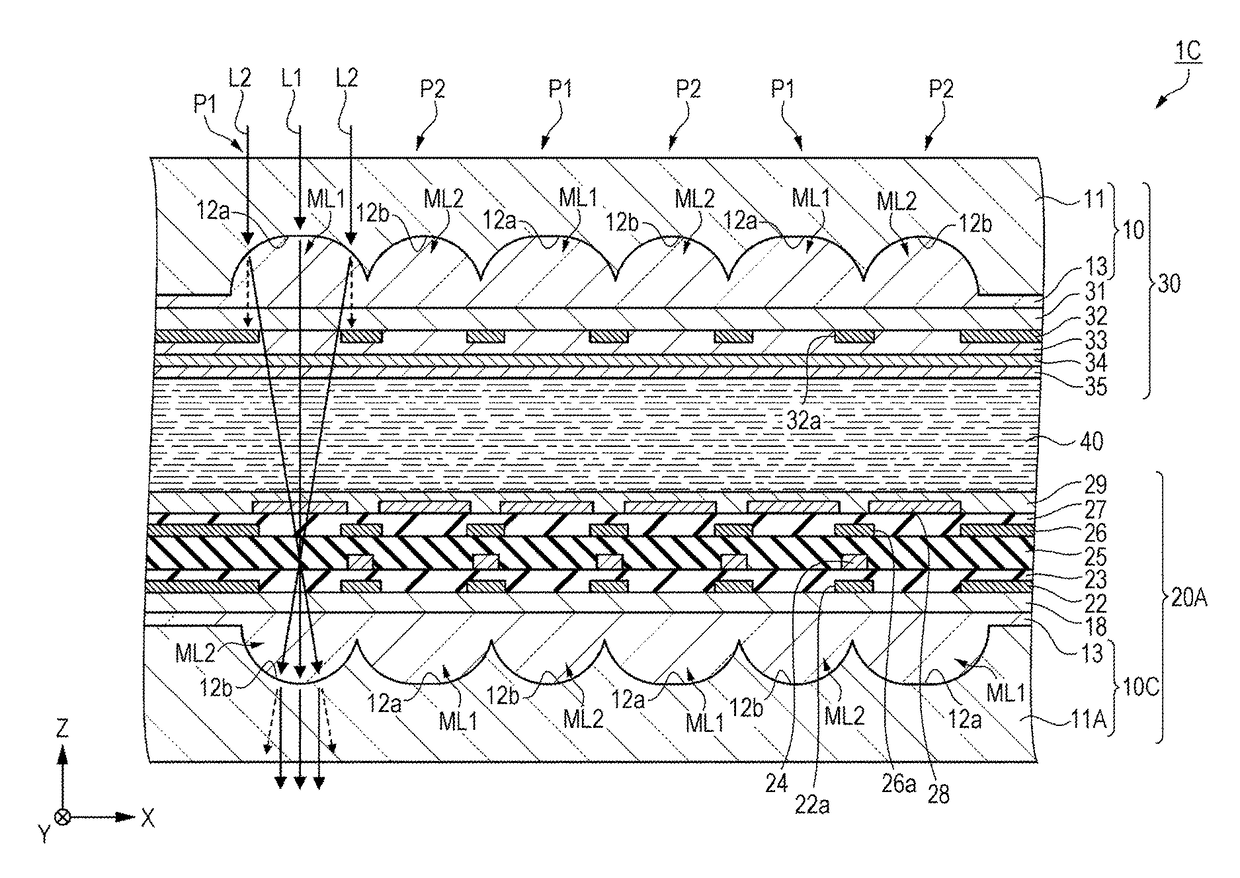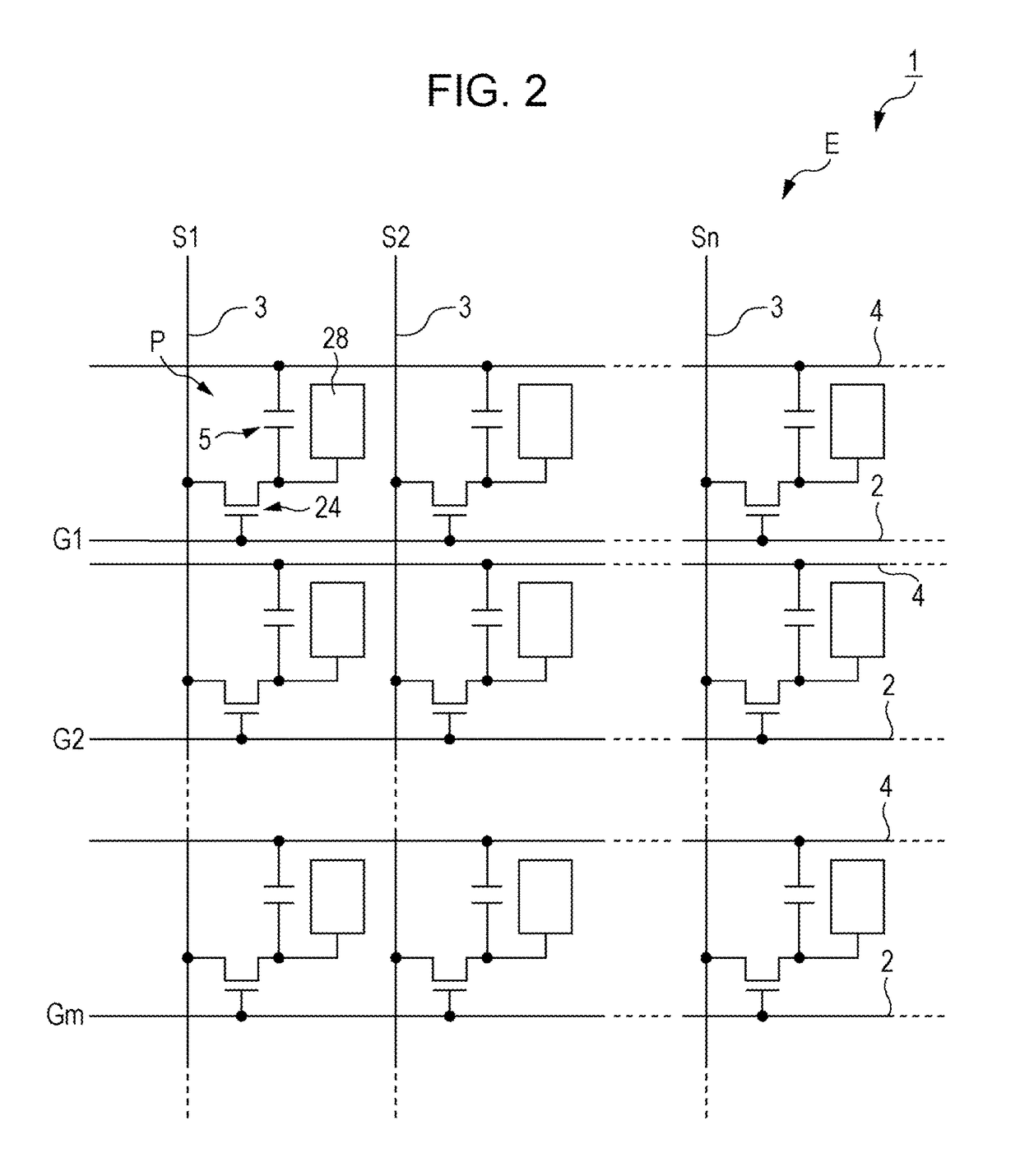Electro-optical device and electronic apparatus
a technology of optical devices and electronic devices, applied in non-linear optics, instruments, optics, etc., can solve the problems of easy generation of diffraction light, increased size of spread of light emitted from liquid crystal devices, and portion of light being subjected to vignetting by projection lenses, etc., to reduce the influence of diffraction light, easy manufacturing, and excellent cost competitiveness
- Summary
- Abstract
- Description
- Claims
- Application Information
AI Technical Summary
Benefits of technology
Problems solved by technology
Method used
Image
Examples
first embodiment
Electro-Optical Device
[0042]Here, description is given exemplifying an active matrix liquid crystal device, which is provided with a Thin Film Transistor (TFT) as a pixel switching element, as the electro-optical device. For example, the liquid crystal device can be favorably used as a light modulating element (a liquid crystal light bulb) of a projection-type display device (a projector) described later.
[0043]First, description will be given of the liquid crystal device as the electro-optical device according to the first embodiment, with reference to FIGS. 1 to 3. FIG. 1 is a schematic plan view showing the configuration of the liquid crystal device according to the first embodiment. FIG. 2 is an equivalent circuit diagram showing the electrical configuration of the liquid crystal device according to the first embodiment. FIG. 3 is a schematic cross-sectional diagram showing a configuration of the liquid crystal device according to the first embodiment. Specifically, FIG. 3 is a s...
second embodiment
[0111]A liquid crystal device according to the second embodiment has a configuration that is substantially the same as that of the first embodiment except in that the configuration of the micro lens array substrate is different. Here, description will be given mainly of the differences in the configuration and the manufacturing method of the micro lens array substrate in relation to the first embodiment. FIG. 8 is a schematic cross-sectional diagram showing the configuration of the liquid crystal device according to the second embodiment. FIGS. 9A and 9B are schematic diagrams showing the configuration of the micro lens substrate according to the second embodiment. Specifically, FIG. 9A is a schematic plan view showing the configuration of the micro lens substrate according to the second embodiment, and FIG. 9B is a plan view showing the arrangement of the micro lenses in the micro lens substrate. Components that are shared with the first embodiment are given the same reference nume...
third embodiment
[0139]A liquid crystal device according to the third embodiment has a configuration that is substantially the same as that of the second embodiment except in that the micro lenses are formed of concave portions that are formed in the substrate in the same manner as in the first embodiment, and in that the micro lenses are disposed to be shifted. Here, description will be given mainly of the differences in the configuration and the manufacturing method of the micro lens array substrate in relation to the above embodiments.
Micro Lens Array Substrate
[0140]FIGS. 12A and 12B are schematic diagrams showing the configuration of a micro lens substrate according to the third embodiment. Specifically, FIG. 12A is a schematic plan view showing the configuration of the micro lens substrate according to the third embodiment, and FIG. 12B is a plan view showing the arrangement of the micro lenses in the micro lens substrate. Components that are shared with the above embodiments are given the same...
PUM
| Property | Measurement | Unit |
|---|---|---|
| width Dt | aaaaa | aaaaa |
| width Dt | aaaaa | aaaaa |
| diameter | aaaaa | aaaaa |
Abstract
Description
Claims
Application Information
 Login to View More
Login to View More - R&D
- Intellectual Property
- Life Sciences
- Materials
- Tech Scout
- Unparalleled Data Quality
- Higher Quality Content
- 60% Fewer Hallucinations
Browse by: Latest US Patents, China's latest patents, Technical Efficacy Thesaurus, Application Domain, Technology Topic, Popular Technical Reports.
© 2025 PatSnap. All rights reserved.Legal|Privacy policy|Modern Slavery Act Transparency Statement|Sitemap|About US| Contact US: help@patsnap.com



